雅思阅读真题话题汇总(草本)
- 格式:doc
- 大小:32.00 KB
- 文档页数:3
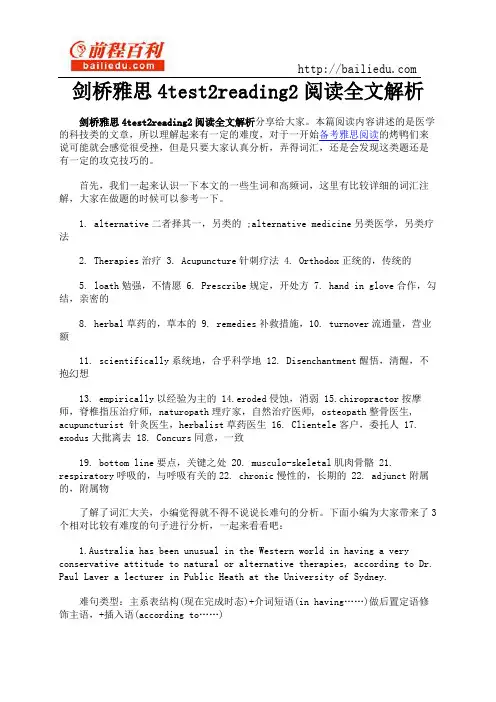
剑桥雅思4test2reading2阅读全文解析剑桥雅思4test2reading2阅读全文解析分享给大家。
本篇阅读内容讲述的是医学的科技类的文章,所以理解起来有一定的难度,对于一开始备考雅思阅读的烤鸭们来说可能就会感觉很受挫,但是只要大家认真分析,弄得词汇,还是会发现这类题还是有一定的攻克技巧的。
首先,我们一起来认识一下本文的一些生词和高频词,这里有比较详细的词汇注解,大家在做题的时候可以参考一下。
1. alternative二者择其一,另类的 ;alternative medicine另类医学,另类疗法2. Therapies治疗3. Acupuncture针刺疗法4. Orthodox正统的,传统的5. loath勉强,不情愿6. Prescribe规定,开处方7. hand in glove合作,勾结,亲密的8. herbal草药的,草本的 9. remedies补救措施,10. turnover流通量,营业额11. scientifically系统地,合乎科学地 12. Disenchantment醒悟,清醒,不抱幻想13. empirically以经验为主的 14.eroded侵蚀,消弱 15.chiropractor按摩师,脊椎指压治疗师, naturopath理疗家,自然治疗医师, osteopath整骨医生, acupuncturist 针灸医生,herbalist草药医生 16. Clientele客户,委托人 17. exodus大批离去 18. Concurs同意,一致19. bottom line要点,关键之处 20. musculo-skeletal肌肉骨骼 21. respiratory呼吸的,与呼吸有关的22. chronic慢性的,长期的 22. adjunct附属的,附属物了解了词汇大关,小编觉得就不得不说说长难句的分析。
下面小编为大家带来了3个相对比较有难度的句子进行分析,一起来看看吧:1.Australia has been unusual in the Western world in having a very conservative attitude to natural or alternative therapies, according to Dr. Paul Laver a lecturer in Public Heath at the University of Sydney.难句类型:主系表结构(现在完成时态)+介词短语(in having……)做后置定语修饰主语,+插入语(according to……)难词注解:conservative保守的难句翻译:悉尼大学公共健康系博士Paul Laver在一次演讲中说到,澳大利亚不管是在自然医学和另类疗法中都持有非常保守的态度,因此它在西方国家中是与众不同的。
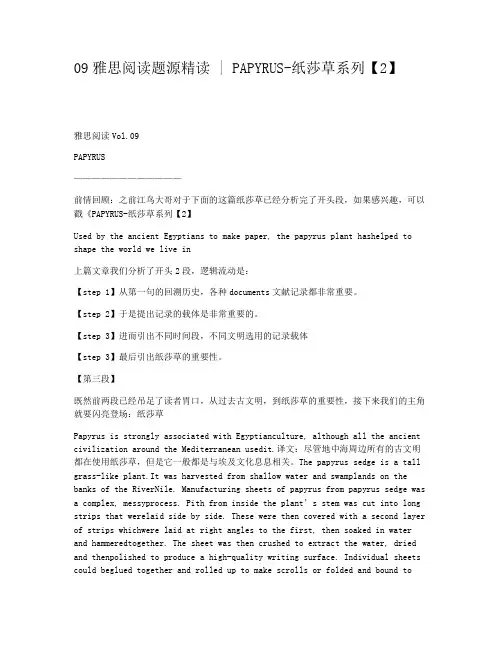
09雅思阅读题源精读 | PAPYRUS-纸莎草系列【2】雅思阅读Vol.09PAPYRUS————————————前情回顾:之前江鸟大哥对于下面的这篇纸莎草已经分析完了开头段,如果感兴趣,可以戳《PAPYRUS-纸莎草系列【2】Used by the ancient Egyptians to make paper, the papyrus plant hashelped to shape the world we live in上篇文章我们分析了开头2段,逻辑流动是:【step 1】从第一句的回溯历史,各种documents文献记录都非常重要。
【step 2】于是提出记录的载体是非常重要的。
【step 3】进而引出不同时间段,不同文明选用的记录载体【step 3】最后引出纸莎草的重要性。
【第三段】既然前两段已经吊足了读者胃口,从过去古文明,到纸莎草的重要性,接下来我们的主角就要闪亮登场:纸莎草Papyrus is strongly associated with Egyptianculture, although all the ancient civilization around the Mediterranean usedit.译文:尽管地中海周边所有的古文明都在使用纸莎草,但是它一般都是与埃及文化息息相关。
The papyrus sedge is a tall grass-like plant.It was harvested from shallow water and swamplands on the banks of the RiverNile. Manufacturing sheets of papyrus from papyrus sedge was a complex, messyprocess. Pith from inside the plant’s stem was cut into long strips that werelaid side by side. These were then covered with a second layer of strips whichwere laid at right angles to the first, then soaked in water and hammeredtogether. The sheet was then crushed to extract the water, dried and thenpolished to produce a high-quality writing surface. Individual sheets could beglued together and rolled up to make scrolls or folded and bound toform books.The papyrus sedge is a tall grass-like plant.莎草是一个像草一样的高植株*莎草:纸莎草的原料接下来的这些句子,单词就有些难度。
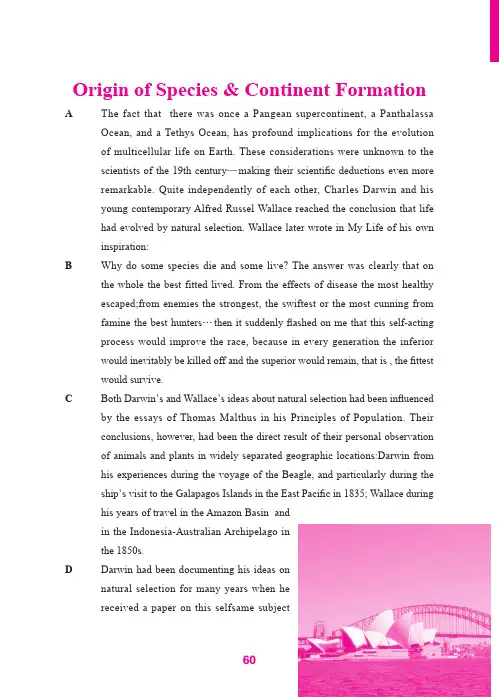
Origin of Species & Continent Formation A T he fact that there was once a Pangean supercontinent, a PanthalassaOcean, and a Tethys Ocean, has profound implications for the evolution of multicellular life on Earth. These considerations were unknown to the scientists of the 19th century—making their scienti fi c deductions even more remarkable. Quite independently of each other, Charles Darwin and his young contemporary Alfred Russel Wallace reached the conclusion that life had evolved by natural selection. Wallace later wrote in My Life of his own inspiration:B W hy do some species die and some live? The answer was clearly that onthe whole the best fitted lived. From the effects of disease the most healthy escaped;from enemies the strongest, the swiftest or the most cunning from famine the best hunters…then it suddenly fl ashed on me that this self-acting process would improve the race, because in every generation the inferior would inevitably be killed off and the superior would remain, that is , the fi ttest would survive.C B oth Darwin’s and Wallace’s ideas about natural selection had been in fl uencedby the essays of Thomas Malthus in his Principles of Population. Their conclusions, however, had been the direct result of their personal observation of animals and plants in widely separated geographic locations:Darwin from his experiences during the voyage of the Beagle, and particularly during the ship’s visit to the Galapagos Islands in the East Paci fi c in 1835; Wallace during his years of travel in the Amazon Basin andin the Indonesia-Australian Archipelago inthe 1850s.D D arwin had been documenting his ideas onnatural selection for many years when hereceived a paper on this selfsame subjectfrom Wallace, who asked for Darwin’s opinion and help in getting it published.In July 1858, Charles Lyell and J. D Hooker, close friends of Darwin, pressed Darwin to present his conclusions so that he would not lose priority to and unknown naturalist. Presiding over the hastily called but now historic meeting of the Linnean Society in London, Lyell and Hooker explained to the distinguished members how “these two gentlemen” (who were absent:Wallace was abroad and Darwin chose not to attend), had “independently and unknown to one another, conceived the same very ingenious theory, ”E B oth Darwin and Wallace had realized that the anomalous distributionof species in particular regions had profound evolutionary significance.Subsequently, Darwin spent the rest of his days in almost total seclusion thinking and writing mainly about the origin of species. In contrast, Wallace applied himself to the science of biogeography, the study of the pattern and distribution of species, and its significance, resulting in the publication of a massive two-volume work the Geographical Distribution of Animals in 1876.F W allace was a gentle and modest man, but also persistent and quietlycourageous. He spent years working in the most arduous possible climates and terrains, particularly in the Malay archipelago, he made patient and detailed zoological observations and collected huge number of specimens for museums and collectors-which is how he made a living. One result of his work was the conclusion that there is a distinct faunal boundary, called “Wallace’s line, “between an Asian realm of animals in Java, Borneo and the Philipiones and an Australian realm in New Guinea and Australia. In essence this boundary posed a dif fi cult question: How on Earth did plants and animals with a clearaffinity to the Northern Hemisphere meet with their Southern Hemispheric counterparts along such a distinct Malaysian demarcation zone? Wallace was uncertain about demarcation on one particular island-Celebes, a curiously shaped place that is midway between the two groups. Initially he assigned its fl ora-fauna to the Australian side of the line, but later he transferred it to theAsian side. Today we know the reason for his dilemma. 200MYA East and West Celebes were islands with their own natural history lying on opposite sides of the Tethys Ocean. They did not collide until about 15 MYA. The answer to the main question is that Wallace’s Line categorizes Laurasia-derived flora-fauna (the Asian) and Gondwana-derived flora-fauna (the Australian), fauna that had evolved on opposing shares of the Tethys. The closure of the Tethys Ocean today is manifested by the ongoing collision of Australia/New Guinea with Indochina/Indonesia and the continuing closure of the Mediterranean Sea—a remnant of the Western Tethys Ocean.G I n his origin of continents and oceans, Wegener quoted at length fromWallace’s Geographical Distribution of Animals. According to Wegener’s reading, Wallace had identified three clear divisions of Australian animals, which supported his own theory of continental displacement. Wallace had shown that animals long established in southwestern Australia had an af fi nity with animals in South Africa, Madagascar, India, and Ceylon, but did not have an af fi nity with those in Asia. Wallace also showed that Australian marsupialsand monotremes are clearly related tothose in South America, the Moluccas,and various Pacific islands, and that noneare found in neighboring Indonesia. Fromthis and related data, Wegener concluded that the then broadly accepted “landbridge” theory could not account for this distribution of animals and that only his theory of continental drift could explain it.H T he theory that Wegener dismissed in preference to his own proposed thatplants and animals had once migrated across now-submerged intercontinental landbridges. In 1885, one of Europe’ s leading geologists, Eduard Suess, theorized that as the rigid Earth cools, its upper crust shrinks and wrinkles like the withering skin of an aging apple. He suggested that the planet’s seas and oceans now fi ll the wrinkles between once-contiguous plateaus.I T oday, we know that we live on a dynamic Earth with shifting, colliding andseparating tectonic plates, not a “withering skin”, and the main debate in the fi eld of biogeography has shifted. The discussion now concerns “ dispersalism”versus “vicarianism: unrestricted radiation of species on the one hand and thedevelopment of barriers to migration on the other. Dispersion is a short-term phenomenon—the daily or seasonal migration of species and their radiation to the limits of their natural environment on an extensive and continuous landmass. Vicarian evolution, however, depends upon the separation and isolation of a variety of species within the con fi nes of natural barriers in the form of islands, lakes, or shallow seas—topographical features that take a long time to develop.Questions 1-5 .................................................................................Use the information in the passage to match the people (listed A-E) with opinions or deeds below. Write the appropriate letters A-E in boxes 1-5 on your answer sheet.NB you may use any letter more than onceA SuessB WallaceC Darwin and WallaceD WegenerE Lyell and Hooker1Persuade Darwin to publish his scienti fi c fi ndings2Depicted physical feature of earth’s crust.3Introduced continental drift theory.4Published works about wildlife distribution in different region.5Evolution of species is based on selection by nature.Questions 6-8 .................................................................................The reading Passage has nine paragraphs A-I.Which paragraph contains the following information?Write the correct letter A-I, in boxes 6-8 on your answer sheet.6Best adaptable animal survived on the planet.7Boundary called Wallace’s line found between Asia and Australia.8Animal relevance exists between Australia and Africa.Questions 9-13 ............................................................................... SummaryComplete the following summary of the paragraphs of Reading Passage, using no more than words from the Reading Passage for each answer. Write your answers in boxes 9-13 on your answer sheet.Wegener found that continental drift instead of “land bridge” theory could explain strange species’ distribution phenomenon. In his theory, vegetation and wildlife 9 intercontinentally. However, Eduard Suess compared the wrinkle of crust to 10of an old apple. Now it is well known that we are living on a constant mobile 11instead of what Suess described. Hot spot in biogeography are switched to concerns between two terms: “ 12”and “13”。
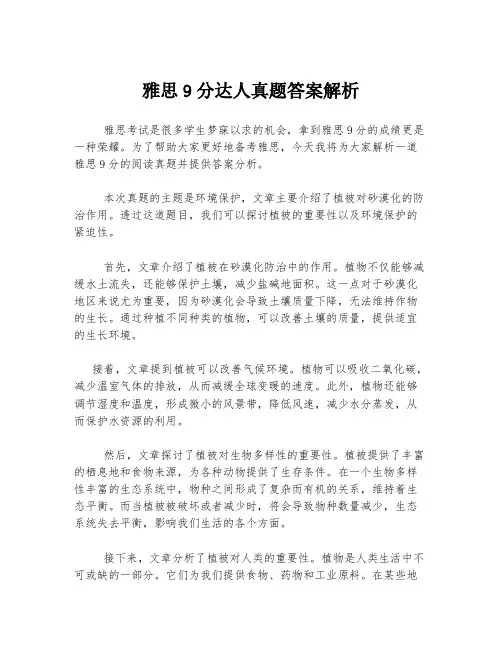
雅思9分达人真题答案解析雅思考试是很多学生梦寐以求的机会,拿到雅思9分的成绩更是一种荣耀。
为了帮助大家更好地备考雅思,今天我将为大家解析一道雅思9分的阅读真题并提供答案分析。
本次真题的主题是环境保护,文章主要介绍了植被对砂漠化的防治作用。
透过这道题目,我们可以探讨植被的重要性以及环境保护的紧迫性。
首先,文章介绍了植被在砂漠化防治中的作用。
植物不仅能够减缓水土流失,还能够保护土壤,减少盐碱地面积。
这一点对于砂漠化地区来说尤为重要,因为砂漠化会导致土壤质量下降,无法维持作物的生长。
通过种植不同种类的植物,可以改善土壤的质量,提供适宜的生长环境。
接着,文章提到植被可以改善气候环境。
植物可以吸收二氧化碳,减少温室气体的排放,从而减缓全球变暖的速度。
此外,植物还能够调节湿度和温度,形成微小的风景带,降低风速,减少水分蒸发,从而保护水资源的利用。
然后,文章探讨了植被对生物多样性的重要性。
植被提供了丰富的栖息地和食物来源,为各种动物提供了生存条件。
在一个生物多样性丰富的生态系统中,物种之间形成了复杂而有机的关系,维持着生态平衡。
而当植被被破坏或者减少时,将会导致物种数量减少,生态系统失去平衡,影响我们生活的各个方面。
接下来,文章分析了植被对人类的重要性。
植物是人类生活中不可或缺的一部分。
它们为我们提供食物、药物和工业原料。
在某些地区,居民靠种植植物为生,从中获取收入和就业机会。
因此,保护植被也就是保护我们自己的生活方式和利益。
最后,文章呼吁人们加强环境保护意识,采取有效的措施防止砂漠化。
在采取措施的同时,应该注重可持续发展,寻找更为环保和经济效益的解决方案。
只有通过全球合作和共同努力,我们才能真正解决环境问题,保护我们的地球家园。
通过对这篇雅思9分达人真题的解析,我们可以看到环境保护的重要性以及植被在其中的作用。
希望大家能够重视环境问题,保护我们的地球,共同创造一个更加美好的未来。
文章长度:590字。
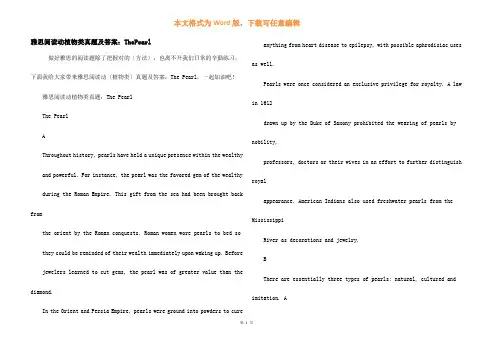
雅思阅读动植物类真题及答案:ThePearl做好雅思的阅读题除了把握对的〔方法〕,也离不开我们日常的辛勤练习,下面我给大家带来雅思阅读动〔植物类〕真题及答案:The Pearl,一起加油吧!雅思阅读动植物类真题:The PearlThe PearlAThroughout history, pearls have held a unique presence within the wealthy and powerful. For instance, the pearl was the favored gem of the wealthy during the Roman Empire. This gift from the sea had been brought back fromthe orient by the Roman conquests. Roman women wore pearls to bed so they could be reminded of their wealth immediately upon waking up. Before jewelers learned to cut gems, the pearl was of greater value than the diamond.In the Orient and Persia Empire, pearls were ground into powders to cure anything from heart disease to epilepsy, with possible aphrodisiac uses as well.Pearls were once considered an exclusive privilege for royalty. A law in 1612drawn up by the Duke of Saxony prohibited the wearing of pearls by nobility,professors, doctors or their wives in an effort to further distinguish royalappearance. American Indians also used freshwater pearls from the MississippiRiver as decorations and jewelry.BThere are essentially three types of pearls: natural, cultured and imitation. Anatural pearl (often called an Oriental pearl) forms when an irritant, such asa piece of sand, works its way into a particular species of oyster, mussel, orclam. As a defense mechanism, the mollusk secretes a fluid to coat the irritant.Layer upon layer of this coating is deposited on the irritant until a lustrouspearl is formed.CThe only difference natural pearls and cultured pearls is that the irritant isa surgically implanted bead or piece of shell called Mother of Pearl. Often, these shells are ground oyster shells that are worthsignificant amounts of money in their own right asirritant-catalysts for quality pearls. The resultingcore is, much larger than in a natural pearl. Yet,as long as there are enough layers of nacre (thesecreted fluid covering the irritant) to result in abeautiful, gem-quality pearl, the size of the nucleusis of no consequence to beauty or durability.DPearls can come from either salt or freshwater sources. Typically, saltwaterpearls tend to be higher quality, although there are several types of freshwaterpearls that are considered high in quality as well. Freshwater pearlstend tobe very irregular in shape, with a puffed rice appearance the most prevalent.Nevertheless, it is each individual pearls merits that determines value morethan the source of the pearl. Saltwater pearl oysters are usually cultivated inprotected lagoons or volcanic atolls. However, most freshwater cultured pearlssold today come from China. Cultured pearls are the response of the shell to atissue implant. A tiny piece of mantle tissue from a donor shell is transplantedinto a recipient shell. This graft will form a pearl sac and the tissue willprecipitate calcium carbonate into this pocket. There are a number of optionsfor producing cultured pearls: use freshwater or seawater shells, transplantthe graft into the mantle or into the gonad, add a spherical bead or do it nonbeaded.The majority of saltwater cultured pearls are grown with beads.ERegardless of the method used to acquire a pearl, the process usually takesseveral years. Mussels must reach a mature age, which can take up t0 3 years,and then be implanted or naturally receive an irritant. Once the irritantisin place, it can take up to another 3 years for the pearl to reach its full size.Often, the irritant may be rejected, the pearl will be terrifically misshapen, orthe oyster may simply die from disease orcountless other complications. By the endof a 5 t0 10 year cycle, only 50% of theoysters will have survived. And of the pearlsproduced, only approximately 5% are ofsubstantial quality for top jewelry makers.From the outset, a pearl fanner can figureon spending over $100 for every oysterthat is farmed, of which many will produce nothing or die.FImitation pearls are a different storyaltogether. In most cases, a glass bead isdipped into a solution made from fishscales. This coating is thin and mayeventually wear off. One can usuallytell an imitation by biting on it. Fakepearls glide across your teeth, while thelayers of nacre on real pearls feel gritty.The Island of Mallorca (in Spain) is known for its imitation pearl industry.Quality natural pearls are very rare jewels. The actual value of a natural pearlis determined in the same way as it would be for other “precious” gems. The valuation factors include size, shape, color, quality of surface, orientand luster. In general, cultured pearls are less valuable than natural pearls,whereas imitation pearls almost have no value. One way that jewelers can determine whether a pearl is cultured or natural is to have a gem lab performan x-ray of the pearl. If the x-ray reveals a nucleus, the pearl is likely a beadnucleatedsaltwater pearl. If no nucleus is present, but irregular and small dark inner spots indicating a cavity are visible, combined with concentric rings oforganic substance, the pearl is likely a cultured freshwater. Cultured freshwaterpearls can often be confused for natural pearls which present as homogeneouspictures which continuously darken toward the surface of the pearl. Naturalpearls will often show larger cavities where organic matter has dried out anddecomposed. Although imitation pearls look the part, they do not have thesame weight or smoothness as real pearls, and their luster will also dim greatly.Among cultured pearls, Akoya pearls from Japan are some of the most lustrous.A good quality necklace of 40 Akoya pearls measuring 7mm in diametersellsfor about $1,500, while a super- high quality strand sells for about $4,500. Sizeon the other hand, has to do with the age of the oyster that created the pearl (themore mature oysters produce larger pearls) and the location in which the pearlwas cultured. The South Sea waters of Australia tend to produce the larger pearls; probably because the water along the coast line is supplied with richnutrients from the ocean floor. Also, the type of mussel common to the areaseems to possess a predilection for producing comparatively large pearls.G Historically, the world’s best pearls came from the Persian Gulf, especiallyaround what is now Bahrain. The pearls of the Persian Gulf were natural created and collected by breath-hold divers. The secret to the special luster ofGulf pearls probably derived from the unique mixture of sweet and salt wateraround the island. Unfortunately, the natural pearl industry of the Persian Gulfended abruptly in the early 1930’s with the discovery of large deposits ofoil. Those who once dove for pearls sought prosperity in the economic boomushered in by the oil industry. The water pollution resulting fromspilled oiland indiscriminate over-fishing of oysters essentially ruined the once pristinepearl producing waters of the Gulf. Today, pearl diving is practiced only asa hobby. Still, Bahrain remains one of the foremost trading centers for highquality pearls. In fact, cultured pearls are banned from the Bahrain pearl market, in an effort to preserve the location’s heritage. Nowadays, the largeststock of natural pearls probably resides in India. Ironically, much of India’sstock of natural pearls came originally from Bahrain. Unlike Bahrain, which has essentially lost its pearl resource, traditional pearl fishing is still practicedon a small scale in India.雅思阅读真题答案解析——pearl珠宝1 A【原文参考根据-A】第2句话 the pearl was the favored gem of th wealthy during the Roman Empire.在罗马帝国时代,珠宝是深受富人宠爱的宝贝。
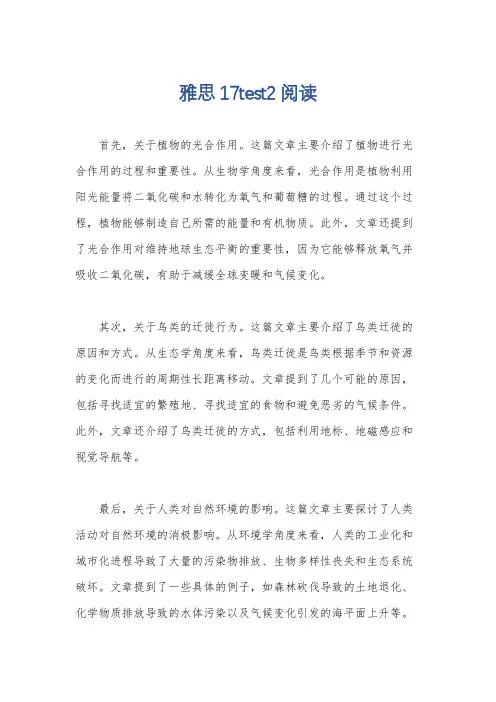
雅思17test2阅读
首先,关于植物的光合作用。
这篇文章主要介绍了植物进行光合作用的过程和重要性。
从生物学角度来看,光合作用是植物利用阳光能量将二氧化碳和水转化为氧气和葡萄糖的过程。
通过这个过程,植物能够制造自己所需的能量和有机物质。
此外,文章还提到了光合作用对维持地球生态平衡的重要性,因为它能够释放氧气并吸收二氧化碳,有助于减缓全球变暖和气候变化。
其次,关于鸟类的迁徙行为。
这篇文章主要介绍了鸟类迁徙的原因和方式。
从生态学角度来看,鸟类迁徙是鸟类根据季节和资源的变化而进行的周期性长距离移动。
文章提到了几个可能的原因,包括寻找适宜的繁殖地、寻找适宜的食物和避免恶劣的气候条件。
此外,文章还介绍了鸟类迁徙的方式,包括利用地标、地磁感应和视觉导航等。
最后,关于人类对自然环境的影响。
这篇文章主要探讨了人类活动对自然环境的消极影响。
从环境学角度来看,人类的工业化和城市化进程导致了大量的污染物排放、生物多样性丧失和生态系统破坏。
文章提到了一些具体的例子,如森林砍伐导致的土地退化、化学物质排放导致的水体污染以及气候变化引发的海平面上升等。
此外,文章还呼吁人们采取积极的措施,如减少碳排放、保护生物
多样性和可持续利用自然资源,以减轻人类对自然环境的负面影响。
综上所述,雅思17test2阅读部分涵盖了植物的光合作用、鸟
类的迁徙行为以及人类对自然环境的影响。
通过从生物学、生态学
和环境学的角度分析这些文章,我们可以更全面地了解这些话题的
重要性和相关的问题。
希望这些回答对你有帮助。
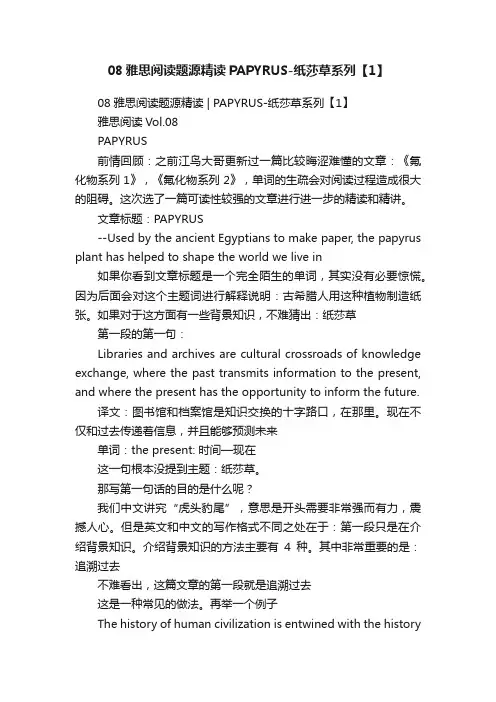
08雅思阅读题源精读PAPYRUS-纸莎草系列【1】08雅思阅读题源精读 | PAPYRUS-纸莎草系列【1】雅思阅读Vol.08PAPYRUS前情回顾:之前江鸟大哥更新过一篇比较晦涩难懂的文章:《氟化物系列1》,《氟化物系列2》,单词的生疏会对阅读过程造成很大的阻碍。
这次选了一篇可读性较强的文章进行进一步的精读和精讲。
文章标题:PAPYRUS--Used by the ancient Egyptians to make paper, the papyrus plant has helped to shape the world we live in如果你看到文章标题是一个完全陌生的单词,其实没有必要惊慌。
因为后面会对这个主题词进行解释说明:古希腊人用这种植物制造纸张。
如果对于这方面有一些背景知识,不难猜出:纸莎草第一段的第一句:Libraries and archives are cultural crossroads of knowledge exchange, where the past transmits information to the present, and where the present has the opportunity to inform the future.译文:图书馆和档案馆是知识交换的十字路口,在那里。
现在不仅和过去传递着信息,并且能够预测未来单词:the present: 时间—现在这一句根本没提到主题:纸莎草。
那写第一句话的目的是什么呢?我们中文讲究“虎头豹尾”,意思是开头需要非常强而有力,震撼人心。
但是英文和中文的写作格式不同之处在于:第一段只是在介绍背景知识。
介绍背景知识的方法主要有4种。
其中非常重要的是:追溯过去不难看出,这篇文章的第一段就是追溯过去这是一种常见的做法。
再举一个例子The history of human civilization is entwined with the historyof the ways we have learned to manipulate water resources.译文:人类文明的历史和人类学会利用水资源的历史交织在一起,息息相关。
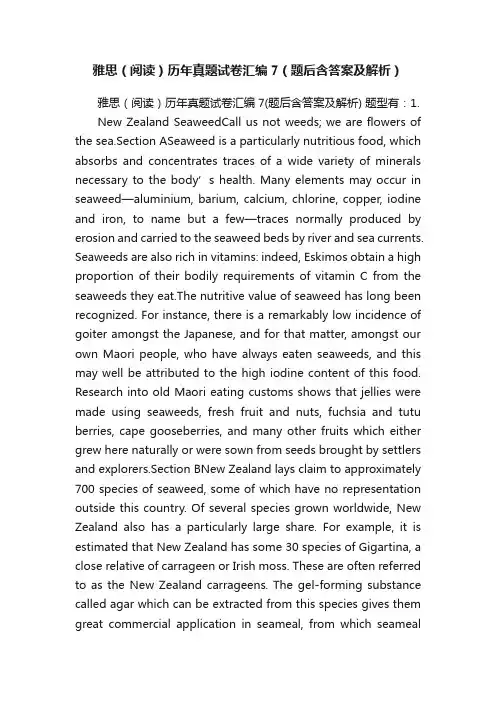
雅思(阅读)历年真题试卷汇编7(题后含答案及解析)雅思(阅读)历年真题试卷汇编7(题后含答案及解析) 题型有:1.New Zealand SeaweedCall us not weeds; we are flowers of the sea.Section ASeaweed is a particularly nutritious food, which absorbs and concentrates traces of a wide variety of minerals necessary to the body’s health. Many elements may occur in seaweed—aluminium, barium, calcium, chlorine, copper, iodine and iron, to name but a few—traces normally produced by erosion and carried to the seaweed beds by river and sea currents. Seaweeds are also rich in vitamins: indeed, Eskimos obtain a high proportion of their bodily requirements of vitamin C from the seaweeds they eat.The nutritive value of seaweed has long been recognized. For instance, there is a remarkably low incidence of goiter amongst the Japanese, and for that matter, amongst our own Maori people, who have always eaten seaweeds, and this may well be attributed to the high iodine content of this food. Research into old Maori eating customs shows that jellies were made using seaweeds, fresh fruit and nuts, fuchsia and tutu berries, cape gooseberries, and many other fruits which either grew here naturally or were sown from seeds brought by settlers and explorers.Section BNew Zealand lays claim to approximately 700 species of seaweed, some of which have no representation outside this country. Of several species grown worldwide, New Zealand also has a particularly large share. For example, it is estimated that New Zealand has some 30 species of Gigartina, a close relative of carrageen or Irish moss. These are often referred to as the New Zealand carrageens. The gel-forming substance called agar which can be extracted from this species gives them great commercial application in seameal, from which seamealcustard is made, and in cough mixtures, confectionery, cosmetics, the canning, paint and leather industries, the manufacture of duplicating pads, and in toothpastes. In fact, during World War II, New Zealand Gigartina were sent to Australia to be used in toothpaste.Section CYet although New Zealand has so much of the commercially profitable red seaweeds, several of which are a source of agar(Pterocladia, Gelidium, Chondrus, Gigartina), before 1940 relatively little use was made of them. New Zealand used to import the Northern Hemisphere Irish moss(Chondrus crispus)from England and ready-made agar from Japan. Although distribution of the Gigartina is confined to certain areas according to species, it is only on the east coast of the North Island that its occurrence is rare. And even then, the east coast, and the area around Hokiangna, have a considerable supply of the two species of Pterocladia from which agar is also available. Happily, New Zealand-made agar is now obtainable in health food shops. Section D Seaweeds are divided into three classes determined by colour—red, brown and green—and each tends to live in a specific location. However, except for the unmistakable sea lettuce(Ulva), few are totally one colour; and especially when dry, some species can change colour quite significantly—a brown one may turn quite black, or a red one appear black, brown, pink or purple. Identification is nevertheless facilitated by the。
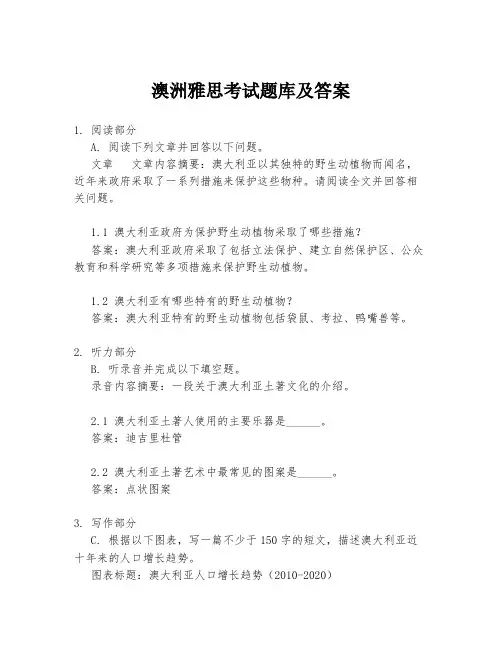
澳洲雅思考试题库及答案1. 阅读部分A. 阅读下列文章并回答以下问题。
文章文章内容摘要:澳大利亚以其独特的野生动植物而闻名,近年来政府采取了一系列措施来保护这些物种。
请阅读全文并回答相关问题。
1.1 澳大利亚政府为保护野生动植物采取了哪些措施?答案:澳大利亚政府采取了包括立法保护、建立自然保护区、公众教育和科学研究等多项措施来保护野生动植物。
1.2 澳大利亚有哪些特有的野生动植物?答案:澳大利亚特有的野生动植物包括袋鼠、考拉、鸭嘴兽等。
2. 听力部分B. 听录音并完成以下填空题。
录音内容摘要:一段关于澳大利亚土著文化的介绍。
2.1 澳大利亚土著人使用的主要乐器是______。
答案:迪吉里杜管2.2 澳大利亚土著艺术中最常见的图案是______。
答案:点状图案3. 写作部分C. 根据以下图表,写一篇不少于150字的短文,描述澳大利亚近十年来的人口增长趋势。
图表标题:澳大利亚人口增长趋势(2010-2020)答案示例:根据图表显示,澳大利亚在过去十年中经历了稳定的人口增长。
2010年人口约为2300万,到2020年增长至约2600万。
这一增长趋势主要受到移民政策和高生育率的影响。
4. 口语部分D. 准备并进行一个2分钟的个人陈述,主题为“你最喜欢的澳大利亚旅游景点”。
答案示例:我最喜欢的澳大利亚旅游景点是大堡礁。
它是世界上最大的珊瑚礁系统,拥有丰富的海洋生物和美丽的自然景观。
我曾在大堡礁潜水,体验了与五彩斑斓的热带鱼和珊瑚共游的乐趣。
此外,大堡礁也是研究海洋生态的重要场所,对保护海洋环境具有重要意义。
以上为澳洲雅思考试题库及答案的示例,考生可根据实际考试内容进行相应的准备和练习。
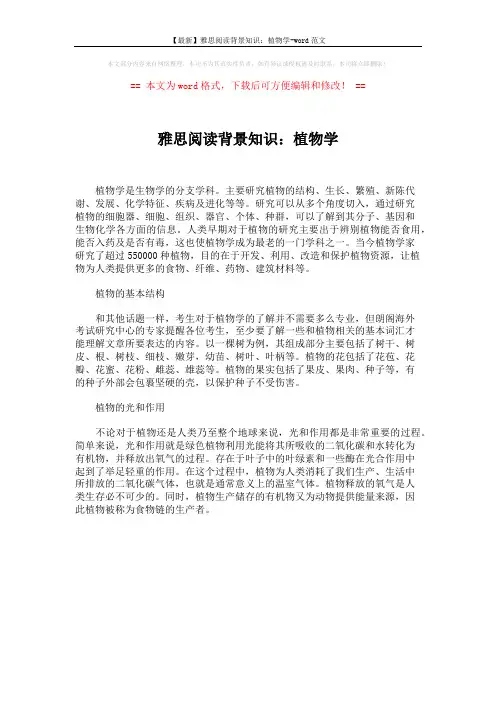
【最新】雅思阅读背景知识:植物学-word范文本文部分内容来自网络整理,本司不为其真实性负责,如有异议或侵权请及时联系,本司将立即删除!== 本文为word格式,下载后可方便编辑和修改! ==雅思阅读背景知识:植物学植物学是生物学的分支学科。
主要研究植物的结构、生长、繁殖、新陈代谢、发展、化学特征、疾病及进化等等。
研究可以从多个角度切入,通过研究植物的细胞器、细胞、组织、器官、个体、种群,可以了解到其分子、基因和生物化学各方面的信息。
人类早期对于植物的研究主要出于辨别植物能否食用,能否入药及是否有毒,这也使植物学成为最老的一门学科之一。
当今植物学家研究了超过550000种植物,目的在于开发、利用、改造和保护植物资源,让植物为人类提供更多的食物、纤维、药物、建筑材料等。
植物的基本结构和其他话题一样,考生对于植物学的了解并不需要多么专业,但朗阁海外考试研究中心的专家提醒各位考生,至少要了解一些和植物相关的基本词汇才能理解文章所要表达的内容。
以一棵树为例,其组成部分主要包括了树干、树皮、根、树枝、细枝、嫩芽,幼苗、树叶、叶柄等。
植物的花包括了花苞、花瓣、花蜜、花粉、雌蕊、雄蕊等。
植物的果实包括了果皮、果肉、种子等,有的种子外部会包裹坚硬的壳,以保护种子不受伤害。
植物的光和作用不论对于植物还是人类乃至整个地球来说,光和作用都是非常重要的过程。
简单来说,光和作用就是绿色植物利用光能将其所吸收的二氧化碳和水转化为有机物,并释放出氧气的过程。
存在于叶子中的叶绿素和一些酶在光合作用中起到了举足轻重的作用。
在这个过程中,植物为人类消耗了我们生产、生活中所排放的二氧化碳气体,也就是通常意义上的温室气体。
植物释放的氧气是人类生存必不可少的。
同时,植物生产储存的有机物又为动物提供能量来源,因此植物被称为食物链的生产者。
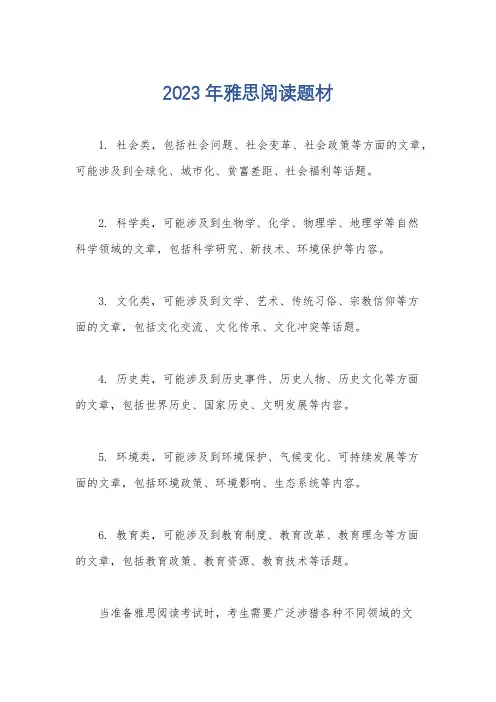
2023年雅思阅读题材
1. 社会类,包括社会问题、社会变革、社会政策等方面的文章,可能涉及到全球化、城市化、贫富差距、社会福利等话题。
2. 科学类,可能涉及到生物学、化学、物理学、地理学等自然
科学领域的文章,包括科学研究、新技术、环境保护等内容。
3. 文化类,可能涉及到文学、艺术、传统习俗、宗教信仰等方
面的文章,包括文化交流、文化传承、文化冲突等话题。
4. 历史类,可能涉及到历史事件、历史人物、历史文化等方面
的文章,包括世界历史、国家历史、文明发展等内容。
5. 环境类,可能涉及到环境保护、气候变化、可持续发展等方
面的文章,包括环境政策、环境影响、生态系统等内容。
6. 教育类,可能涉及到教育制度、教育改革、教育理念等方面
的文章,包括教育政策、教育资源、教育技术等话题。
当准备雅思阅读考试时,考生需要广泛涉猎各种不同领域的文
章,提高自己的阅读理解能力和跨学科的知识水平,以便更好地理解和应对可能出现的各种题材。
同时,平时多读一些英文报纸、杂志、学术期刊等,积累词汇和阅读经验也是非常重要的。
希望这些信息能对你有所帮助。
2024年雅思阅读题目精选(9)题目1:气候变化对生物多样性的影响阅读以下段落,回答问题。
气候变化是目前全球面临的最紧迫的问题之一。
它对生物多样性产生了深远的影响。
许多物种的栖息地正在遭受破坏,导致物种灭绝的速度加快。
此外,气候变化还导致了生态系统的失衡,许多物种无法适应快速变化的环境。
为了保护生物多样性,我们需要采取紧急行动,包括减少温室气体排放、保护自然栖息地以及推广可持续发展的理念。
1. 气候变化对生物多样性的主要影响是什么?2. 为什么气候变化导致了生态系统的失衡?3. 我们应该采取哪些措施来保护生物多样性?题目2:人工智能的发展与应用阅读以下段落,回答问题。
人工智能(AI)是近年来迅速发展的一种技术。
它已经在许多领域产生了深远的影响,包括医疗、金融、交通等。
人工智能的发展不仅改变了我们的生活方式,还为社会带来了许多挑战和问题。
我们需要制定相应的法律法规,以确保人工智能的发展不会对人类造成伤害。
同时,我们也需要提高公众对人工智能的认识,让他们了解其优势和潜在风险。
1. 人工智能在哪些领域产生了深远的影响?2. 人工智能的发展带来了哪些挑战和问题?3. 我们应该如何应对人工智能带来的挑战?题目3:可持续发展与环境保护阅读以下段落,回答问题。
可持续发展是指在不损害环境的前提下,满足当代人的需求,并保证后代也能满足其需求的发展方式。
随着人口的快速增长,资源消耗和环境破坏变得越来越严重。
因此,可持续发展成为了全球关注的焦点。
为了实现可持续发展,我们需要采取一系列措施,包括推广清洁能源、减少废弃物排放、保护自然生态系统等。
1. 什么是可持续发展?为什么它重要?2. 人口快速增长对环境产生了哪些影响?3. 我们应该采取哪些措施来实现可持续发展?请根据以上题目和段落,撰写一份详细的解答文档。
雅思(阅读)历年真题试卷汇编16(题后含答案及解析) 题型有:1.You should spend about 20 minutes on Questions 1-13, which are based on Reading Passage 1 below.The Forgotten ForestFound only in the Deep South of America, longleaf pine woodlands have dwindled to about 3 percent of their former range, but new efforts are under way to restore them.THE BEAUTY AND THE BIODIVERSITY of the longleaf pine forest are well-kept secrets, even in its native South. Yet it is among the richest ecosystems in North America, rivaling tallgrass prairies and the ancient forests of the Pacific Northwest in the number of species it shelters. And like those two other disappearing wildlife habitats, longleaf is also critically endangered.In longleaf pine forests, trees grow widely scattered, creating an open, parklike environment, more like a savanna than a forest. The trees are not so dense as to block the sun. This openness creates a forest floor that is among the most diverse in the world, where plants such as many-flowered grass pinks, trumpet pitcher plants, Venus flytraps, lavender ladies and pineland bog-buttons grow. As many as 50 different species of wildflowers, shrubs, grasses and ferns have been cataloged in just a single square meter.Once, nearly 92 million acres of longleaf forest flourished from Virginia to Texas, the only place in the world where it is found. By the turn of the 21st century, however, virtually all of it had been logged, paved or farmed into oblivion. Only about 3 percent of the original range still supports longleaf forest, and only about 10,000 acres of that is uncut old-growth—the rest is forest that has regrown after cutting. An estimated 100,000 of those acres are still vanishing every year. However, a quiet movement to reverse this trend is rippling across the region. Governments, private organisations(including NWF)and individual conservationists are looking for ways to protect and preserve the remaining longleaf and to plant new forests for future generations.Figuring out how to bring back the piney woods also will allow biologists to help the plants and animals that depend on this habitat. Nearly two-thirds of the declining, threatened or endangered species in the southeastern United States are associated with longleaf. The outright destruction of longleaf is only part of their story, says Mark Danaher, the biologist for South Carolina’s Francis Marion National Forest He says the demise of these animals and plants also is tied to a lack of fire, which once swept through the southern forests on a regular basis. “Fire is absolutely critical for this ecosystem and for the species that depend on it,” says just about any species that occurs in longleaf and you can find a connection to fire. Bach-man’s sparrow is a secretive bird with a beautiful song that echoes across the longleaf flatwoods. It tucks its nest on the ground beneath clumps of wiregrass and little bluestem in the open understory. But once fire has been absent for several years, and a tangle of shrubs starts to grow, the sparrows disappear. Gopher tortoises, the only native land tortoises east of the Mississippi, are also abundant in longleaf. A keystone species for these forests, its burrows provide homes and safety tomore than 300 species of vertebrates and invertebrates ranging from eastern diamond-back rattlesnakes to gopher frogs. If fire is suppressed, however, the tortoises are choked out. “If we lose fire,” says Bob Mitchell, an ecologist at the Jones Center, “we lose wildlife.”Without fire, we also lose longleaf. Fire knocks back the oaks and other hardwoods that can grow up to overwhelm longleaf forests. “They are fire forests,”Mitchell says. “They evolved in the lightning capital of the eastern United States.” And it wasn’t only lightning strikes that set the forest aflame. “Native Americans also lit fires to keep the forest open,”Mitchell says. “So did the early pioneers. They helped create the longleaf pine forests that we know today.”Fire also changes how nutrients flow throughout longleaf ecosystems, in ways we are just beginning to understand. For example, researchers have discovered that frequent fires provide extra calcium, which is critical for egg production, to endangered red-cockaded woodpeckers. Frances James, a retired avian ecologist from Florida State University, has studied these small black-and-white birds for more than two decades in Florida’s sprawling Apalachicola National Forest. When she realised female woodpeckers laid larger clutches in the first breeding season after their territories were burned, she and her colleagues went searching for answers. “We learned calcium is stashed away in woody shrubs when the forest is not burned,”James says. “But when there is a fire, a pulse of calcium moves down into the soil and up into the longleaf.” Eventually, this calcium makes its way up the food chain to a tree-dwelling species of ant, which is the red-cockaded’s favorite food. The result: more calcium for the birds, which leads to more eggs, more young and more woodpeckers.Today, fire is used as a vital management tool for preserving both longleaf and its wildlife. Most of these fires are prescribed burns, deliberately set with a drip torch. Although the public often opposes any type of fire—and the smoke that goes with it—these frequent, low-intensity burns reduce the risk of catastrophic conflagrations. “Forests are going to burn,”says Amadou Diop, NWF’s southern forests restoration manager. “If s just a question of when. With prescribed burns, we can pick the time and the place.”Diop is spearheading a new NWF effort to restore longleaf. “It’s a species we need to go back to,” he says. Educating landowners about the advantages of growing longleaf is part of the program, he adds, which will soon be under way in nine southern states. “Right now, most longleaf is on public land,”says Jerry McCollum, president of the Georgia Wildlife Federation. “Private land is where we need to work,”he adds, pointing out that more than 90 percent of the acreage within the historic range of longleaf falls under this category.Interest among private landowners is growing throughout the South, but restoring longleaf is not an easy task. The herbaceous layer—the understory of wiregrasses and other plants—also needs to be re-created. In areas where the land has not been chewed up by farming, but converted to loblolly or slash pine plantations, the seed bank of the longleaf forest usually remains viable beneath the soil. In time, this original vegetation can be coaxed back. Where agriculture has destroyed the seeds, however, wiregrass must be replanted. Right now, the expense is prohibitive, but researchers are searching for low-cost solutions.Bringing back longleaf is not for the short-sighted, however. Few of us will be alive when the pines being planted today become matureforests in 70 to 80 years. But that is not stopping longleaf enthusiasts. “Today, if s getting hard to find longleaf seedlings to buy,”one of the private landowners says. “Everyone wants them. Longleaf is in a resurgence.”Questions 1-5Complete the notes below.Choose NO MORE THAN TWO WORDS from the passage for each answer.Write your answers in boxes 1-5 on your answer sheet.Forest fire ensures that: Birds can locate their【R1】______in the ground. The burrows of a species of【R2】______provide homes to many other animals. Hardwoods such as【R3】______don’t take over.Apart from fires lit by lightning: Fires are created by【R4】______and settlers. Fires deliberately lit are called【R5】______.1.【R1】正确答案:nests解析:利用细节信息“forest fire”、“birds”和“in the ground”定位于原文第五段前三句话“…you can find a connection to fire.Bachman’s sparrow is a secretive bird…It tucks its neston the ground beneath…”。
雅思(IELTS)考试是世界各地学生前往英语国家留学或就业的重要语言考试。
在雅思考试的阅读部分中,常常会涉及到一些关于植物气味(plant scents)的文章,这类文章一般要求考生理解与分析植物气味对自然环境和人类的影响。
本文将对雅思阅读中关于植物气味的文章进行解析,从多个角度深入探讨这一主题。
1. 植物气味的种类让我们来了解一下植物气味的种类。
植物气味可以分为花香、树木的清香和草的芳香等。
花香多数源自植物的花朵,如玫瑰花的香味、茉莉花的香味等;树木的清香则来自于树木本身的挥发性物质,如松树的清香、橘子树的清香等;而草的芳香则可以来自于草本植物,如薄荷的香味、香草的香味等。
这些气味不仅给人们带来愉悦的感受,同时也对自然环境和人类产生着重要的影响。
2. 植物气味的影响接下来,我们将探讨植物气味对自然环境和人类的影响。
在自然环境中,植物气味可以吸引昆虫传粉,促进植物的繁殖和生长;一些植物气味还能驱赶害虫,保护植物免受侵害。
而在人类社会中,植物气味也发挥着重要的作用,比如在香料、药物、香水等方面的应用。
植物气味还可以影响人们的心情和情绪,如薰衣草的香味有助于放松心情,玫瑰花的香味能够增强人们的幸福感等。
3. 对植物气味的个人观点和理解就我个人而言,植物气味是大自然赐予人类的美好礼物。
每当我走进一片花香弥漫的花园,或是置身于一片树木清香的森林中,心情总是能够得到极大的放松和愉悦。
我也认为植物气味的独特魅力在于它能够让人们更加关注自然环境、注重生态保护,这对于人类可持续发展和环境保护至关重要。
在本文中,我们对雅思考试中关于植物气味的文章进行了深度解析,并从不同角度探讨了植物气味的种类、影响以及个人观点和理解。
通过本文的阅读,相信读者能够对植物气味有一个更加全面、深刻和灵活的理解,为雅思阅读解题提供更多的思路和观点。
以上是我对雅思 plant scents阅读解析的文章撰写,希望能够满足您的要求。
如有需要修改或补充内容,请随时告知,我会及时对文章进行调整。
汇总类雅思阅读常见话题
雅思阅读是雅思考试中较难的部分,因为雅思阅读的时间有限,而且题量有点大,很多同学无法在有限的时间高质量的完成作答。
如果同学们熟悉雅思阅读常见话题的话,那么这样就能节省你的阅读时间,从而更好的完成雅思阅读题目。
雅思阅读常见话题一、生物类话题
自09年以来,生物类的话题几乎是在雅思A类三篇文章中必然出现的一类话题,涉及到的内容有动物的生活习性、基因的研究、器官的研究、植物的光合作用、植物体内的叶绿素等。
这些话题对于很多学生来讲并不十分熟悉,而且涉及到的专业术语多、句子复杂,因此很多学生感到做完题目都没弄懂文章的真正含义,这就需要我们在平时的阅读学习中积累这些话题的背景知识。
雅思阅读常见话题二、地理类话题
地理类话题也是阅读文章中常常摘选的内容,不过相比于上面的生物类,地理类的文章难度较高,因为地理现象涉及的专业名称更多、地名和各种地质现象也更加复杂,在积累地理类知识时,工作量是比较大的。
雅思阅读常见话题三、社会科学类话题
社会科学是一个大类,包含了很多小的分支,比如教育、历史、考古、电脑、日历、垃圾问题、企业管理、音乐、数码产品等等。
以上就是小编为大家整理的“汇总类雅思阅读常见话题”。
Language
C4T2R1 Lost for Words
C5T1R1 Johnson’s Dictionary
C5T2R3 The Birth of Scientific English
C4T3R3 Obtaining Linguistic Data
C9T3R1 Attitude to Language
Environment
C4T1R1 Rainforest
C5T1R3 The Truth about the Environment
C5T3R2 Disappearing Delta
C7T1R2 Making Every Drop Count
C7T2R2 The True Cost of Food (Food)
C7T3R3 Deforestation
C5T4R1 The Impact of Wildness Tourism (Tourism)
Education
C4T2R3 Play is a Serious Business
C5T2R3 Early Childhood Education
C9T2R1 Children Development
Biology
C4T1R2 What Do Whales Feel?
C5T4R3 The Effect of Light on Plant and Animal Species
C7T1R1 Let’s Go Bats (Technology)
C7T3R1 Ant Intelligence
C7T3R2 Population Movement and Genetics (Geography, Society) C8T2R3 The Meaning and Power of Smell
C8T3R3 How Does the Biological Clock Tick?
C8T4R2 Biological Control of Pests
C8T4R3 Collecting Ant Specimens
C8T3R2 The Nature of Genius
Psychology
C4T1R3 Visual Symbols and the Blind
C5T1R2 Nature or Nurture
C5T2R2 What’s so Funny?
C7T1R3 Educating Psycho
C8T1R3 Telepathy
C9T2R3 A Neuroscientist Reveals How to Think Differently C9T4R2 Young Children’s Sense of Identity
Health/ Medicine
C4T2R2 Alternative Medicine in Australia
C4T4R3 The Problem of Scarce Resources
C6T2R2 Greying Population Stays in the Pink
C6T3R3 The Search for Anti-aging Pills
C6T4R1 Doctoring Sales
Technology
C5T2R1 Bakelite
C5T3R3 The Return of Artificial Intelligence
C5T4R2 Flawed Beauty: the Problem with Toughened Glasses C8T1R1 A Chronicle of Timekeeping
C8T2R1 Sheet Glass Manufacture: the Float Process
C9T3R3 Information Theory – the Big Idea
Geography
C4T3R2 V olcanoes-earth-shattering News
C6T1R3 Climate Change and the Inuit
C8T2R2 The Little Ice Age
C8T4R1 Land of the Rising Sum
C9T2R2 Venus in Transit
C9T3R2 Tidal Power
C9T1R2 Is There Anybody out There?
Sports
C4T4R1 How much higher? How much faster?
C6T1R1 Australia Sporting Success
Archaeology
C4T4R2 The Nature and Aims of Archeology
Transport
C6T1R2 Delivering the Goods
C6T2R1 Advantages of Public Transport
C8T1R2 Air Traffic Control in the USA
Science
C6T2R3 Numeration
Media
C6T3R1 Cinema
Society/ Social Life
C4T3R1 Micro-Enterprise Credit for Street Youth
C6T3R2 Motivating Employees under Adverse Conditions C6T4R2 Do Literate Women Make Better Mothers?
C6T4R3 Bullying
C7T2R3 Makete Integrated Rural Transport Project
C7T4R2 Endless Harvest
C7T4R3 Effects of Noise (Environment, Biology)
Architecture
C7T2R1 Why Pagodas don’t Fall down
C7T4R1 Pulling Strings to Build Pyramids
Culture
C8T3R1 Striking Back at Lightning With Lasers (Physics) C9T1R1 William Henry Perkin
C9T1R2 The History of the Tortoise (Biology)
C9T4R1 The Life and Work of Marie Curie
C9T4R3 The Development of Museums。